The 2000s saw an exhausting period of mascot inflation: while Beijing hit a new record with a combined six Olympic and Paralympic mascots, no Games in this decade managed to show restraint in curating their mascot roster. I believe it was the great Eleanor Roosevelt who once said to always take one mascot off before leaving the house—these Olympic committees obviously didn’t listen.
Salt Lake City, Winter 2002: Powder, Copper, Coal, and Otto
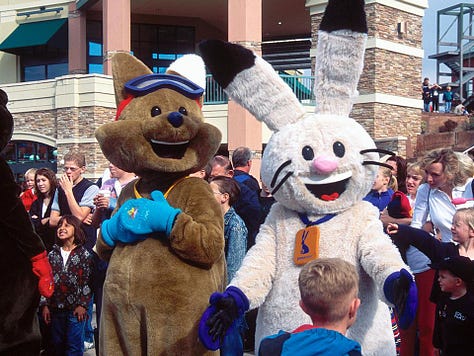

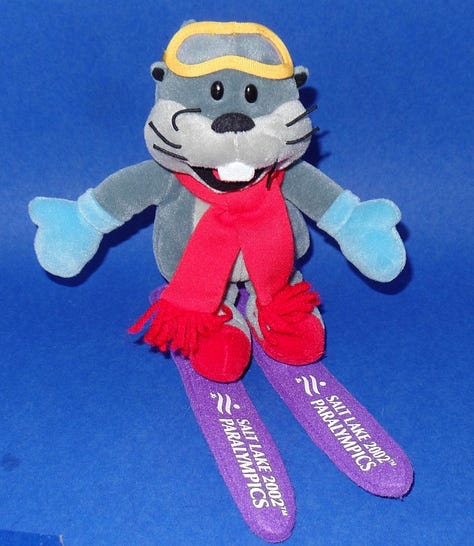
Olympic mascots Powder (a snowshoe hare), Copper (a coyote), and Coal (a black bear) respectively represent the three components of the Olympic motto: faster, higher, and stronger. They each wear amulets featuring Anasazi or Fremont-style petroglyphs as a nod to Utah’s indigenous populations. They were designed by a guy who did animation work on Rugrats and Hercules!
The same artist created Paralympic mascot Otto, who is indeed an otter. Per the Paralympics website, the otter was chosen “because of the animal’s agility and vitality….Having nearly reached extinction in the early 20th century, otters were successfully reintroduced into the wild in 1990, showing that even the largest setbacks can be overcome.” I have to admit I don’t know much about otter history, but this resilience-focused narrative really seems to let off the hook whoever made life so difficult for the otters in the first place—perhaps not unlike how mainstream coverage of Paralympians and other successful individuals with disabilities favors inspirational “anyone can achieve what they put their mind to!” stories over discussion of how ableist societies create structural barriers for people with disabilities. Cute otter though!!
Athens, Summer 2004: Phevos, Athena, and Proteas
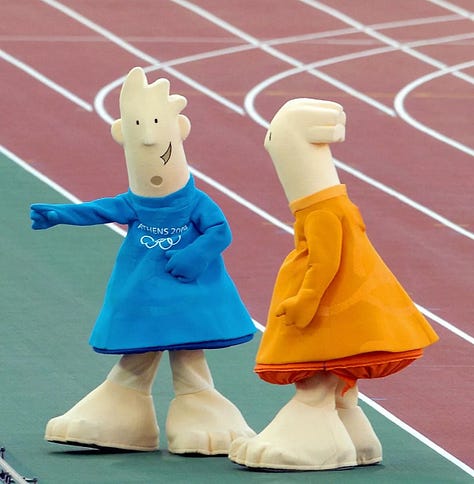
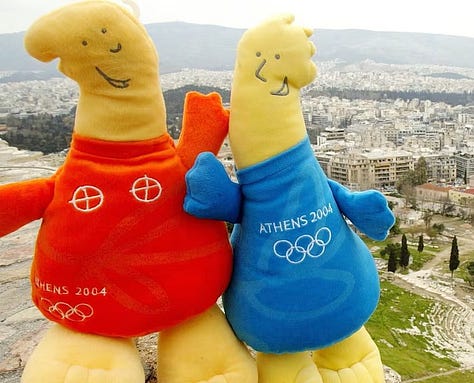

Well, here they are!! Phevos and Athena are siblings based on a type of 7th century Greek sculpture called the daidala, which quite honestly is more normal-looking than these two goofuses. They take their names from Greek gods (Phevos/Phoebus is apparently another name from Apollo?) which provoked great ire among, like…modern people who still follow Hellenic religion. A (seemingly unsuccessful) legal complaint filed by hundreds of Greek citizens claimed: “The choice of these vulgar ‘mascots’ in combination with the impropriate and unexpected use of these two Names, offends in a brutal and scurrilous way some of Greek Civilization’s most ancient and sacred symbols as well as its religious models.”
There’s also Proteas, a cute little seahorse created by the same artist. Per the Paralympic website, he was designed to express the 2004 Paralympic Games’ values of “Strength, Pursuit, Inspiration and Celebration” and “represent the nature of the competitions and the athletes’ constant goal of achieving excellency.” No further information about how the colorful seahorse design does this is available.
Turin, Winter 2006: Neve, Gliz, and Aster

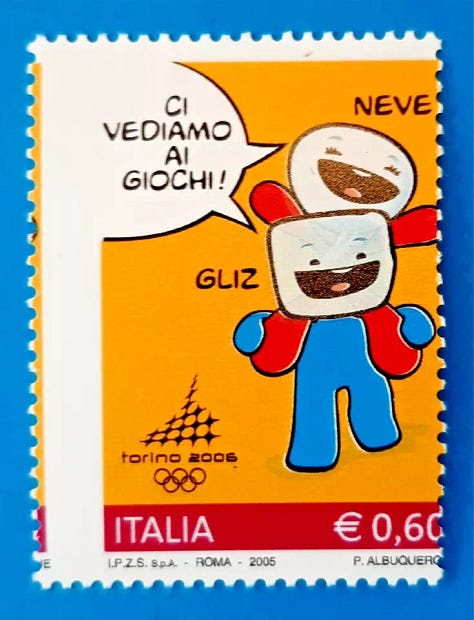
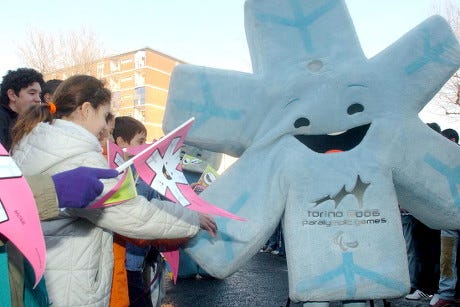
They are an anthropomorphized snow ball and an anthropomorphized ice cube, and I think they are a couple (which I think would make them the first canonically romantically-involved Olympic mascots), but the Neve and Gliz lore is pretty thin.
The Paralympic mascot, Aster, was created by the same designer, a guy named Pedro Albuquerque, which sounds like a fake name a sitcom character would make up on the spot. Being a snowflake, Aster represents how everyone can do sports in their own unique way(?).
Beijing, Summer 2008: The Fuwa (Beibei, Jingjing, Huanhuan, Yingying, and Nini) and Fu Niu Lele
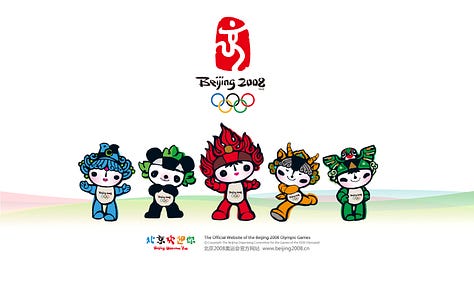
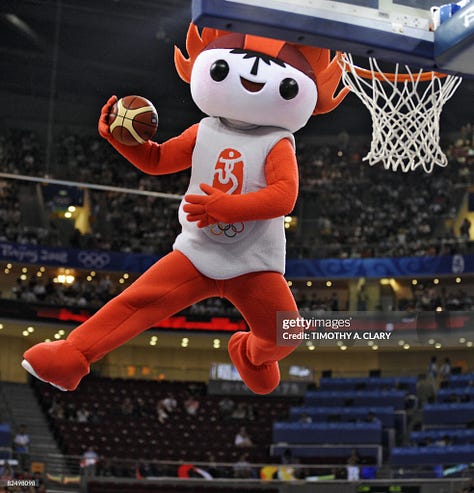
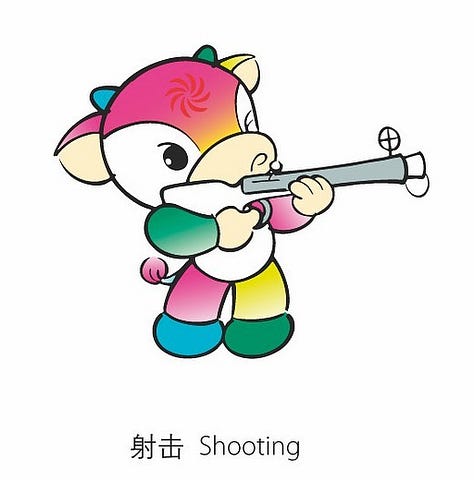
The Fuwa are dolls meant to bring good luck. Beibei, the blue one, represents fish and water, and takes her head waves from traditional Chinese art. Jingjing, the black one, represents pandas and forests, and gets the lotus flowers on his head from Song dynasty porcelain paintings. The red one is Huanhuan, who represents fire and is inspired by art from the Dunhuang Caves. Yingying, the yellow guy, represents earth and Tibetan antelopes, and has Western Chinese artistic vibes. And then Nini is green and represents the sky and swallows, and is inspired by Chinese kites. Put together, their names spell out “Beijing welcomes you!”
Creator Han Meilin originally wanted the mascots to be five kiddos representing fire, wood, water, gold, and earth, but Olympics organizers kept asking him to add additional symbolic elements to the increasingly-convoluted designs. “There had to be a panda, even though you'd think the public would have had enough of them,” he told Wall Street Journal. Meilin had two heart attacks during the design process and today excludes them from a museum dedicated to his work. If you’re dying to see the Fuwa in person, you’d apparently be better off going to the woods near an abandoned Beijing mall, where multiple gigantic Fuwa statues lie face down on the ground.
Meanwhile, there is Paralympic mascot Fu Niu Lele, a cute cow who has nothing to do with the Fuwa. A charmer!!
Vancouver, Winter 2010: Miga, Quatchi, Sumi, and Mukmuk
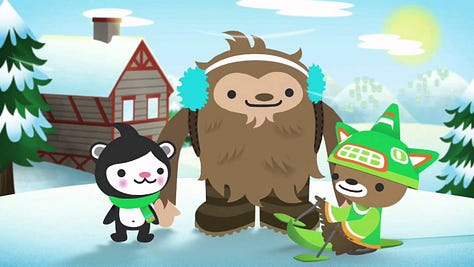
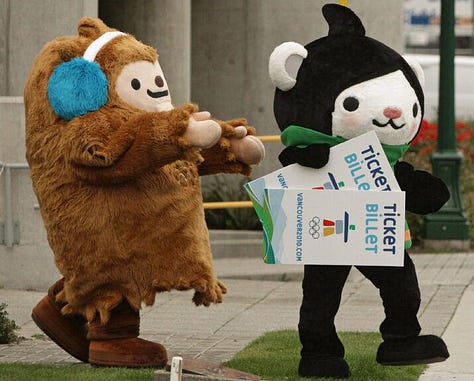
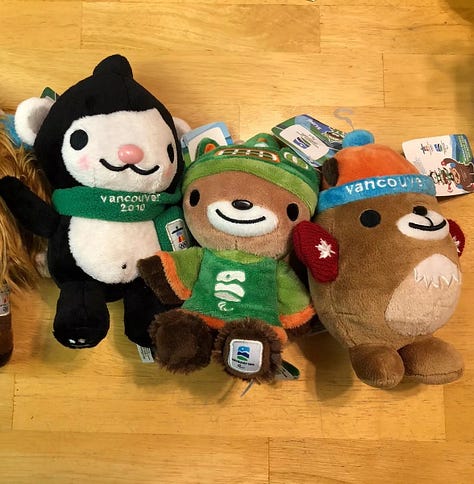
Olympic mascots Miga (a mythical sea bear) and Quatchi (a sasquatch) are joined by thunderbird and Paralympic mascot Sumi as well as marmot sidekick Mukmuk. To my knowledge, Mukmuk is the only ever Olympic mascot sidekick, perhaps largely because “Olympic mascot sidekick” is such a deeply unnecessary and unintuitive concept that it never occurred to anyone else to have one; it seems like his job was to hang out with the other mascots but mostly only do so on the internet. Honestly, he was ahead of his time!





Neve and Gliz remind me of marshmallows. Nicely toasted and gooey.
“Phevos” is the modern Greek equivalent of “Phoibos” (often Latinized/Anglicized to “Phoebus”), one of the most common epithets for Apollo! Sometimes he’s referred to as Phoibos in place of his name, but often you see Phoibos Apollo in ancient Greek texts.